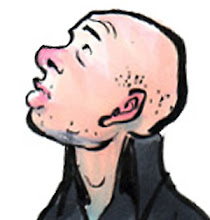Here's the basic run down on the brush strokes I use, going across the page left to right:
1. Finest Lines are reserved for fine hatching (which can look like halftone), construction lines at the beginning of the drawing, and small detail. I use 'em esp'ly at the beginning of a drawing, as this is moment when the brush is "freshest," and therefore most likely to have a good enough tip to lay down these very fine lines. Even in the course of a single drawing the tip will get fuzzed, and/or the tip won't be saturated with enough ink to let me make a fine, wet line.
To get my thinnest lines: (1) the tip's got to have enough ink that it won't start dry-brushing on me (2) I "find my range" (a.k.a furthest distance I can hold the brush from the page and still make contact). To do this I start with the brush above the page and begin "ghosting" or practicing the motion for the mark I want to put down, lowering the brush with each stroke until I make contact--I won't "feel" the page, but I'll see the pen begin to make a wisp of a mark--when I do, I maintain that brush height and proceed with making my mark(s), making sure to (3) put almost no pressure on the brush as I'm doing this. This is one of the great things about these Muji pens--although they're cheap, they've got a very fine tip with a lot of spring in it. That means when they're fresh the tip almost wants to "grab" the page--I think of the way the foot of an ant can just barely make contact with a surface, yet get enough grip to hold that bug upside down.
2. Normal Lines are done like the finest lines, (often tracing the line I want in the air a few times before "range-finding" my way down to the page), but I add slight pressure to the pen. These are the marks I'm making 50% of the time. You can see how varying the pressure really varies the lines. (Note: this pen was dry-brushing a bit too much on me this morning for me to get a really good array of line variants, but you get the idea). Again, it's the spring in the tip that allows for a lot of the liveliness you see in the drawings on this site.
3. Fat Strokes are done by adding pressure. It doesn't take much pressure to get the bristles to really flare like this--or break! This straight-to-the-page pressure really thrashes the brushes fast, so I try to limit it to a flourish here and there. If you're clever, you can drag the brush almost parallel to the page to get the bristles to flare without a lot of pressure, and then keep that shape to sweep in a few marks. Even this is really hard on the shape of the brush, and you'll lose your consistent tip in no time. To forestall this awful moment, I use a compromise brush stroke called....
4. The Sidewinder. To do this I lay the brush way down and swipe the side of the bristles against the page. It can give interesting, if erratic results. You can sweep into this brush stroke from any other position, i.e., I can start off drawing a normal line, with the brush basically perpendicular to the page, but then I swing the brush onto it's side and transition my line into a wider, softer-edged "sidewinder" mark. Allows me to get good line variation without having to constantly stop and start my lines, too. Speed is of the essence when you're drawing from life--esp'ly when the subjects are unwitting civilians.
An important tip: While rolling the barrel of the pen from upright to this sidewinder position, I try to give the pen a little twist so the bristles won't get caught between the lowering action of the pen and the page--if they do get caught, they can flare out and catch--and this hastens the death of the tip. But if I can roll the barrel, the bristles will tuck in on themselves, and the brush will transition from contacting the page with its TIP (a.k.a., the ends of all the brush hairs), and onto the shafts, or sides of all these hairs. This prolongs brush life.
It's a handy stroke for keeping speed and spontaneity without destroying the brush before I'm done with the sketch. Also, I can go back in on these sidewinder marks and reinforce or refine them, usually weighting one edge or the other (example in the drawing above, lower right-hand corner). And another variant on this is turning the whole pen as I'm making one of these sidewinders--a lot of times I turn the brush into the direction I'm going with the line, so the brush almost becomes a wet mop I'm dragging behind my hand movement--depending on the angle between brush and page, this can fan the bristles even more, or allow the bristles to regroup and return to a finer line.
09 May, 2012
Subscribe to:
Post Comments (Atom)


No comments:
Post a Comment